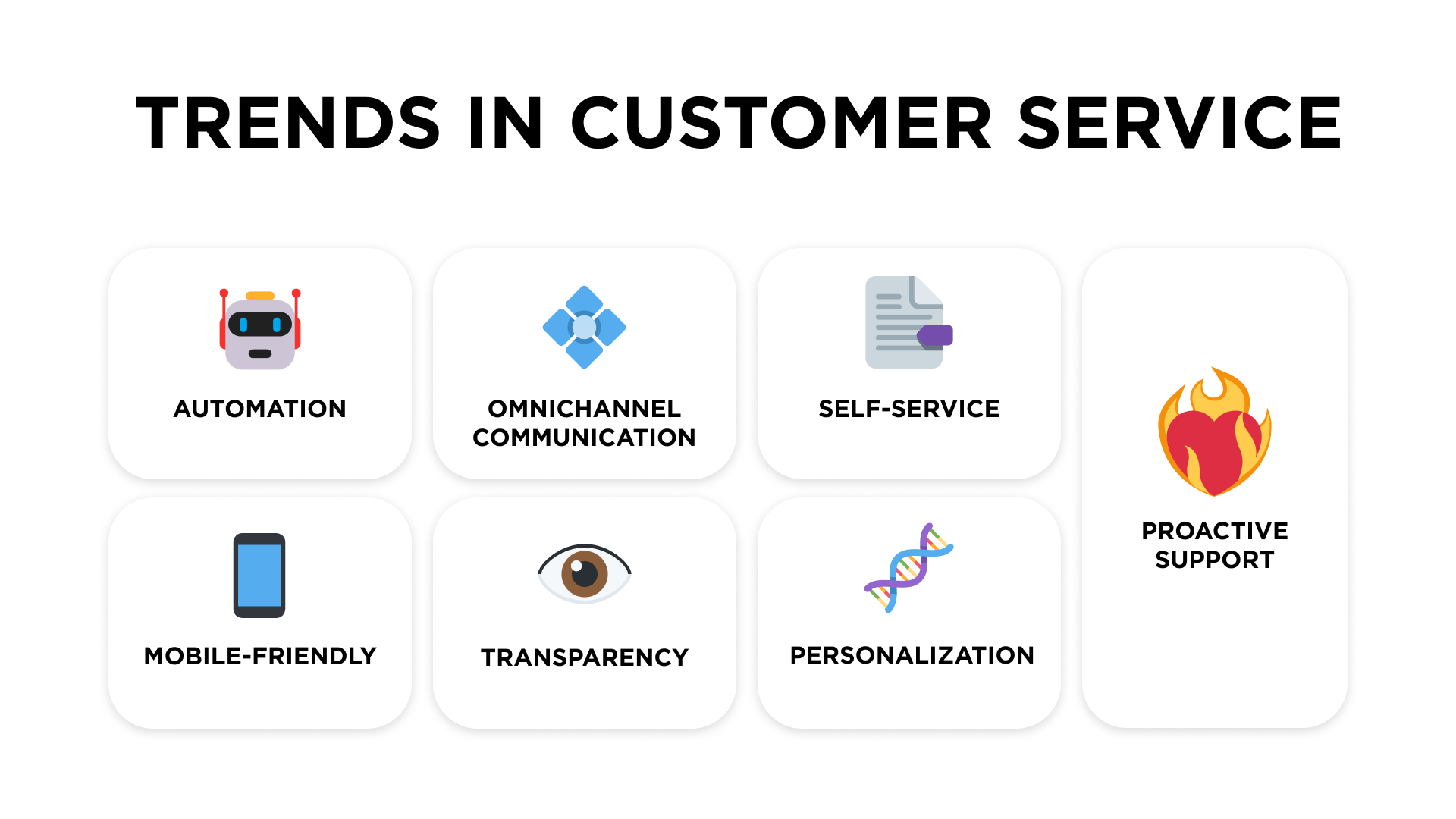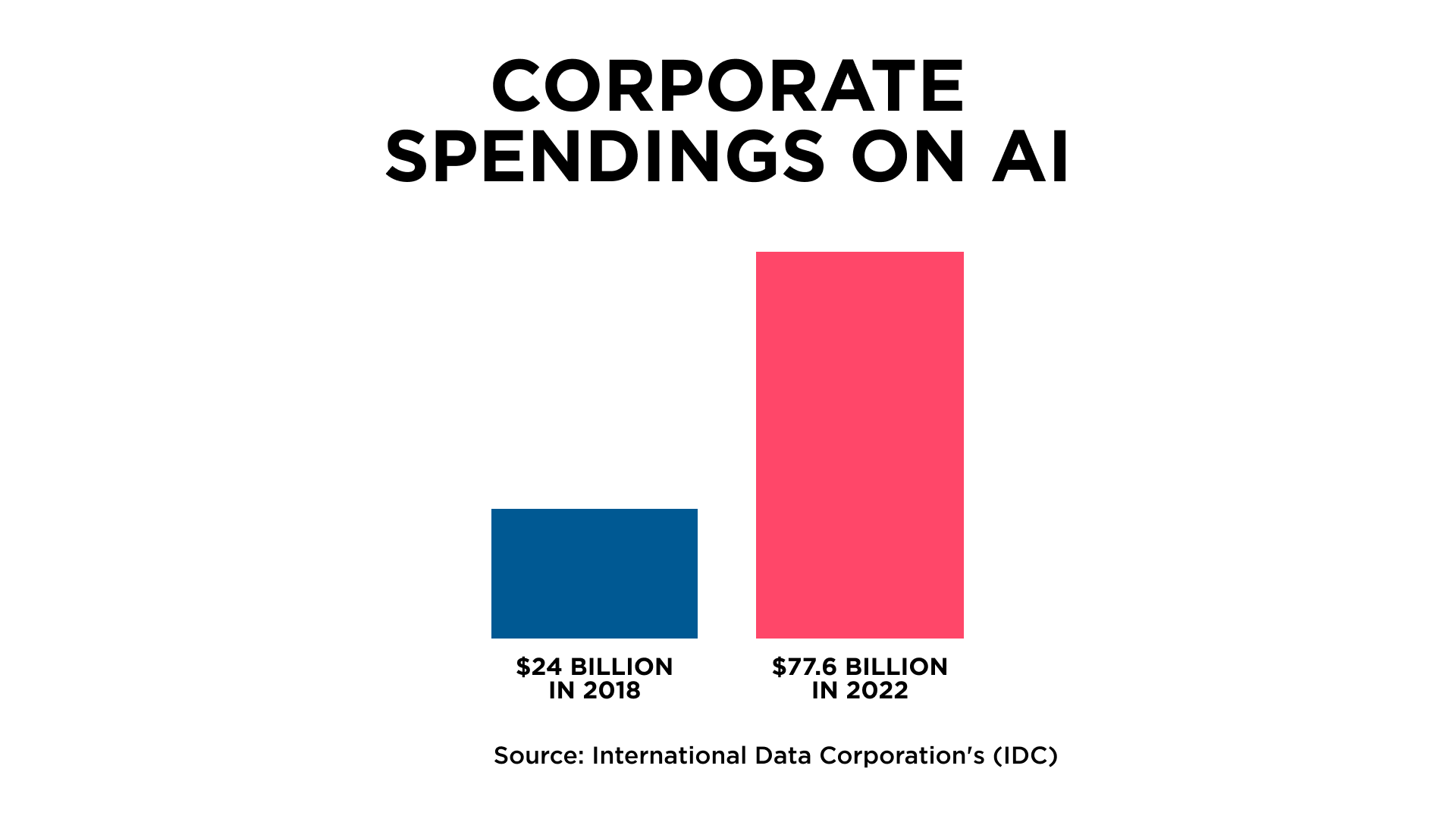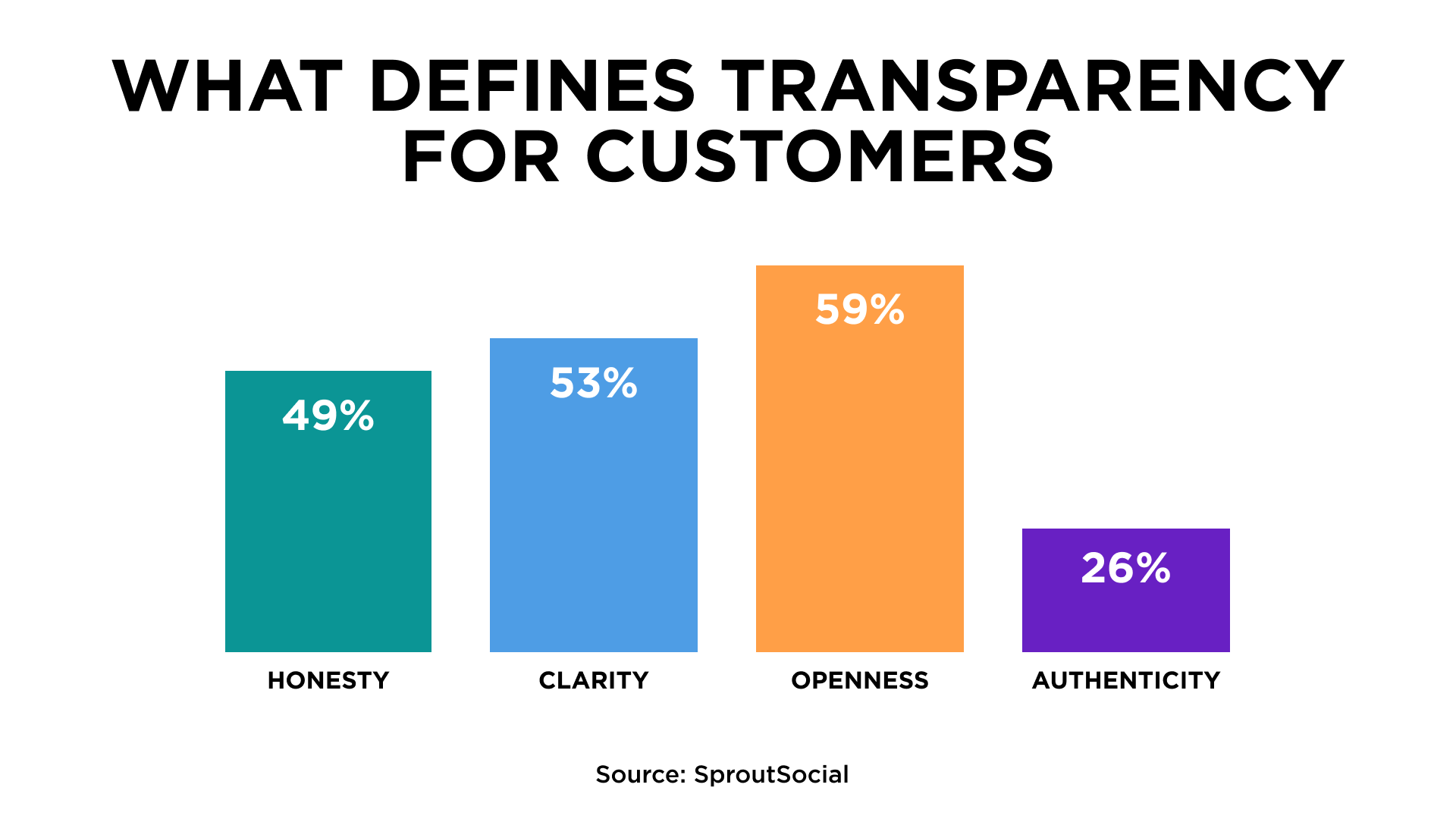Customer Service Trends to Watch in 2024
Reviewing the trends in customer service every business should keep their eye on.

The way we discover brands, shop for things, book services and interact with companies in general changes constantly. So does customer service or, to say it more accurately, what we consider to be good customer service. When it comes to support, consumers have much higher expectations in speed, personalization, and overall quality than a decade or two ago. To maintain customer loyalty and attract new clients, it is important to meet these expectations or even exceed them. In the article, we’ll explore what trends drive the support industry in 2024 and why it is important to keep up with its latest developments.
Top 10 Customer Service Trends for 2024
Technologies in customer service include digital tools and strategies of their usage aimed at delivering high quality support to customers with the highest ROI (return on investment) possible.
From call centers to chatbots and from individual shopping assistance to post-purchase surveys. All of these technologies and the concepts of using them make a business more customer-focused and help to establish a two-way customer communication that is adapted both to clients’ preferences and the company’s goals.
The high competition that characterizes many industries and the ongoing revolution in the field of AI-based technologies has led to the emergence of several strong trends in customer service and support. Let’s learn more about each of them and how a business can utilize them in the best possible manner.

AI and automation
Currently, we can see how AI technologies for understanding humans get more sophisticated and become capable of executing more complex actions. Just take ChatGTP for example, which can write concise programming code or an article on a given subject in a matter of minutes. These technological developments haven’t gone unnoticed in the customer service sphere as well.
The brightest example of using automation in CS, which is adopted by more and more countries around the world, is, of course, chatbots. A recent study by Tidio shows that for some types of inquiries (checking order status, booking a meeting, finding promotions and discounts) more than 60% of customers are perfectly okay with being helped by a chatbot instead of another human being. Combined with just 17% of people considering that chatbots are overused by companies, this figure shows how welcomed such customer service automation is.

Other automation trends are on the rise as well. More companies adopt automatic voice response strategies for call centers and analyze incoming emails and posts in social media for keywords with subsequent automatic tagging and categorizing of them. All of this makes it possible for companies of all sizes to provide faster and more efficient support and be available 24/7 without significant increases in the budget allocated for customer service.
Decreasing demand for human agents
The logical consequence of the trend described above is that, while over the past 5-7 years the demand for employees has grown, it has been heavily disrupted by the rise of automation technologies such as AI, chatbots, and self-service support options. These technologies have shown that they can perform some operations in customer support just as effectively as humans or even better. Businesses understand that a high-quality customer support experience can differentiate them in a competitive market. The aim is not to replace human agents but to augment their capabilities and allow them to focus on more complex tasks. While automation may reduce certain roles, it also presents opportunities for new roles and industries to emerge.
Centralization of data
A common problem of today is how organizations have customer data dispersed across various systems, leading to a lack of comprehensive understanding of their customers. This fragmentation often results in inconsistent customer experiences, departmental miscommunication, and overlooked opportunities.
This can be solved by unifying customer data into a single, comprehensive view, enabling a complete understanding of the customer journey across all channels. The process involves identifying and eliminating separate clusters of data, and using the right data integration tools and cost-effective storage to build a single unified database that can be easily governed, accessed, and protected. The benefits of this approach include easier delivery of personalized experiences based on the needs and preferences of clients, increased efficiency, better decision-making, and a competitive advantage.
Omnichannel messaging
It is no longer enough for brands to communicate with their clients through email and phone channels. Gradually, social media and instant messengers transform from one-way communication tools, where only brands can ‘speak’ through promotional, educational, and informational content, into two-way tools for brand-client dialogue, where clients can ask a question, get advice, and share their thoughts with a company’s representatives.
One study showed that the COVID-19 pandemic saw a 200% surge in the number of support tickets submitted through WhatsApp and a 25% increase of them sent via social media platforms. This clearly demonstrates customers’ preference to connect with brands via familiar platforms that they use in their everyday lives for chatting with friends, discussing work, and enjoying (or creating) textual and visual content.
In 2024, personalized omnichannel messaging is no longer an additional option but a must-have part of marketing and customer service strategy. The key difficulty here, especially palpable for small and medium-sized businesses, lies in establishing an efficient workflow with customers in so many channels. The constant switching between tabs and manual combining of conversation details from various messengers is bound to impede the quality and speed of provided support. The solution is to adopt an omnichannel messaging platform, such as Umnico Inbox, that merges customer communication in multiple channels in a single intuitive interface. In line with the trend for data centralization, Umnico provides users with access to unified client profiles and histories of previous conversations, and team managers with detailed analytics on employees’ performance and trends in customer inquiries.

Self-service support
Often, clients choose to solve issues or find answers to their questions on their own instead of speaking with a customer support representative. One study by Zendesk shows that about 67% of interview customers would prefer finding a solution themselves rather than speaking to an agent. There are several reasons for this but the ultimate takeaway here is that self-service support options are an essential trend, adding significant value and improving the brand’s image by assisting customers in their preferred way.
In 2024, it is important for a company to maintain an up-to-date knowledge base that can be easily navigated. To pick the relevant content for it, it pays off to explore the most popular customer support inquiries and analyze the most frequent issues. It is also impossible not to mention how this trend is directly related to the two described earlier: an AI-based search can significantly improve the knowledge base navigation experience, while omnichannel support makes a knowledge base easily available from social media and messengers.
Mobile-friendly services
Smartphones play an essential role in both e-commerce & digital services and as a tool for enhancing experiences in the physical world (checking product reviews and comparing prices, for example). Today, with the larger (and steadily increasing) share of web traffic attributed to mobile devices, customer service should be tailored and accessible from smartphones. This means adapting a brand’s website and live chat widget for smaller screens and providing prompt support via instant messengers, such as WhatsApp, Telegram, and others. Mobile-accessible customer service helps clients solve issues arising at any stage of their customer journey on the go, improving loyalty and brand appreciation.
Transparency
In our digital era, transparency is one of the essential aspects of business. Dishonesty in pricing, advertising, and describing a product’s capabilities is bound to get uncovered at some point and take away customer trust for years to come. By contrast, it is easier for people to see the reflection of their values and ideals in a business that makes honesty a priority in its operations.
It is important to point out that, for a company, it's hard to be transparent with clients while having a low level of transparency internally, so corporate transparency can be regarded as the first step on the way to more openness in customer relations. Generally, brands should be ready to let clients into their kitchens: present details on supply chains, ways of sourcing materials, private data handling, and so on. Also, transparency decreases the chances of creating false expectations for customers, which, when unfulfilled, can be a powerful negative factor for public brand’s perception.

Security
Security in customer service is a hot and rapidly evolving trend. The expansion of the variety of cyber attacks due to the use of IoT systems, open-source code, cloud applications, complex digital supply chains, and social media requires companies to update their approaches to security monitoring, detection, and response.
Cybercriminals are increasingly targeting the digital supply chain, focusing on accessing management infrastructure. As a result, credential fraud has become a primary attack vector. In response to these threats, organizations are emphasizing the recruitment of data privacy officers and implementing measures such as role-based access control, multi-factor authentication, encryption in transit and at rest, and external assessments. These security trends underscore the growing importance of adapting the strategy of a business to protect its digital footprint and ensure a secure customer experience.
Personalization
The increasing competition and rising consumer expectations leave small chances for success to companies that treat every client the same. Today, it is important to personalize customer service on all levels and personalization has become one of the key social media customer service trends. From simply addressing a client by their name to creating special promotions for them, all of this becomes a norm rather than a pleasant exception.
Thankfully, there is no shortage of digital solutions that help with analyzing audience preferences and segmenting it according to the results, providing a complete overview of the history of a client profile and their interactions with a brand (previous purchases, sizes (for fashion e-shop), and so on). By utilizing customer data collected through these tools, brands can achieve a high level of personalization and scale it to an entire client base.
Proactive support
For many years, customer support existed in a paradigm of reactive response to incoming inquiries. However, things have taken a shift lately, as an approach that thinks one step further, foresees possible issues, and attempts to solve them before a customer contacts customer service to gain widespread adoption. For 2024, we see a strong tendency among companies to increase efforts in this area, sending surveys post purchase, reaching out first to website visitors via free live chat, etc. All of these practices help to increase customer satisfaction, which is arguably one of the most important metrics for a business.
Summing things up
Businesses invest heavily in the quality of their customer service, researching innovative digital tools and adopting them for their purposes of more personalized, transparent, and convenient support. In 2024, we’re likely to see the increased usage of automation in customer service, while even more brands will expand their support channels from email and phone to social media and messengers, striving for omnichannel communication with clients.
For companies seeking to streamline their customer interactions across multiple channels and be prepared for upcoming challenges in customer service, Umnico omnichannel messaging platform can become an indispensable instrument. From routine automation and insightful analytics, to secure and stable integrations with 25+ messaging apps, Umnico has it all. A free trial available to all new users makes it easy to test the platform’s business usefulness without paying anything.

Subscribe to Umnico news!
Be the first to get recommendations and up-to-date information
